Parrot Bebop with Skycontroller
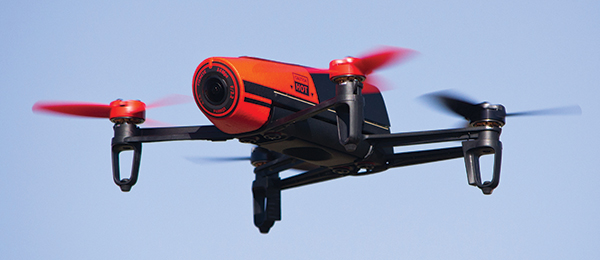
Written by Terry Dunn. Full-fledged camera platform in a small package. Flight video and product release video. Full review in the July 2015 issue of Model Aviation.
Specifications
Model type: Aerial photography quadcopter Diameter: 9.76 inches Flying weight: 13.9 ounces Radio system: Parrot Skycontroller, tablet, or smartphone Needed to complete: Nothing Power System (included): four brushless motors, four three-blade propellers, 3S 1,200 mAh LiPo (three included: one for Bebop, one for Skycontroller, one spare). Flight time: 8-11 minutes Minimal flying area: Indoor basketball court or park Street price: $899.99; $499.99 without SkycontrollerPluses
• Complete package. • Adjustable flying traits. • Good camera performance.Minuses
• Instructions scattered across several sources. • Camera memory not expandable. There are several small multirotors on the market that come equipped with a camera. In many cases, however, the attached camera is a novelty upsell with marginal image quality. If capturing captivating photos and video is your goal, you need a multirotor capable of hauling the appropriate camera gear. This often requires a sizable aircraft, but not always. The Parrot Bebop is the smallest multirotor I’ve seen that is intended to be a full-fledged camera platform. It has many of the same features as larger multirotors, such as GPS, brushless motors, and video downlink, but its integrated components allow it to have a significantly smaller footprint and weight.What’s in the Box
The Bebop bridges the gap between hobby-grade aerial vehicles and consumer electronics. It has many of the features that we expect in a serious RC aircraft, but the user interface is tailored to the needs of someone without RC experience. The Bebop can be purchased alone and can be controlled by a smartphone or tablet, or in a bundle that includes the aircraft and Parrot’s Skycontroller transmitter. The aircraft is a small quadcopter—roughly 9.76 inches diameter from either front propeller shaft to the opposite rear propeller shaft—and is constructed primarily of ABS plastic. Each corner of the Bebop contains a small brushless motor with a 5-inch-diameter three-blade propeller. A full-set of spare propellers is included in the box. The Bebop’s built-in camera is encased in a foam shroud located between the front motors. It is capable of 14 megapixel still photos and high-definition video at 1,080 pixels/30 frames per second. Such camera performance isn’t exactly cutting edge these days, but it’s good for most aerial work. Three 3S-1200 mAh LiPo batteries are included in the Skycontroller combo (two batteries come in the aircraft-only package). One battery powers the Bebop and another provides juice for the Skycontroller, leaving a spare battery for more flight time. A one-hour AC wall charger is included as well. I’ve found that I can get anywhere from eight to 11 minutes of flight time with each battery. The Bebop is small enough that it can be flown in larger indoor venues such as a basketball court. For those occasions, a set of clip-on propeller protectors (Parrot collectively calls them the “hull”) are provided. These plastic and foam bumpers give an extra level of security for the Parrot’s propellers and whatever they might otherwise come in contact with. The Skycontroller looks like a cross between a standard RC transmitter and a control yoke that you would find in the cockpit of a Boeing airliner. Despite its unusual appearance, it functions like a normal transmitter—with a two-axis gimbal on each side to control the Bebop. The empty space in the middle includes a clamp for holding a smartphone or tablet to display the video downlink from the quadcopter. A tall, folding sunshade is also included so the screen can be seen without sun glare when flying outside.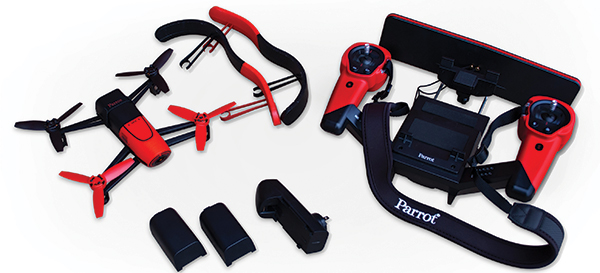
The Parrot Bebop with Skycontroller is a complete aerial photography package. You can integrate a smartphone or tablet if you want to see real-time video from the quadcopter.

The Bebop features small outrunner brushless motors.
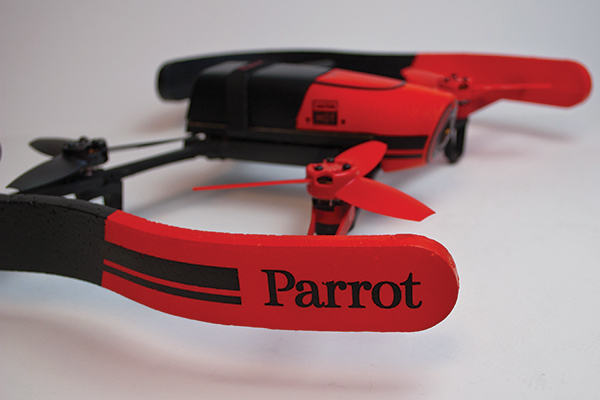
A set of clip-on foam propeller protectors is included for indoor flying.
Preparing the Bebop
No assembly is required to get the Bebop airworthy, but you will need to install the FreeFlight 3 app on your smartphone or tablet. This program allows you to view real-time video from the camera, alter flight settings, view tutorials, and update the quadcopter’s onboard software. I installed the software on my iPad Mini tablet. Whether using the Skycontroller or a tablet to command the Bebop, the connection is a Wi-Fi link at either 2.4 or 5 GHz. The first time I connected the Bebop to my tablet, it prompted me to update the system, but the method for doing so was not very intuitive. I was able to find the instructions that I needed to update the Bebop, but the experience was the first instance of a recurring frustration I had with the package. Between the printed quick-start guides, downloadable manuals, and tutorial videos, everything you need to know is available—you just have to know where to look for it. I found myself wishing for a single, comprehensive source containing all of the information. Within the FreeFlight 3 application, there are menus to adjust the performance of the Bebop (maximum ascent rate, yaw rate, tilt, etc.). The stock settings are probably fine if you have some experience flying multirotors (including tiny, inexpensive micro-quadcopters), but it may be slightly too sporty if the Bebop is your first multirotor. Rookies can simply tone down the flight parameters and they’ll be fine. The application also allows you to configure things such as the quadcopter’s maximum altitude and photo settings. There are only a few menus, so the setup process doesn’t take long.Flying the Bebop
For my first flights with the Bebop, I left the Skycontroller in the box and used the iPad Mini for control. I wanted to be able to compare the relative piloting experiences of the two methods. It takes 30 seconds or so for the Bebop to boot up. After that, you must connect your tablet to the quadcopter’s Wi-Fi network and launch FreeFlight 3. What you end up with is something similar to a heads-up display in a jet cockpit. The tablet screen shows the view through the Bebop’s onboard camera. Overlaid on this image are emulated cyber joysticks and an array of buttons. Make sure that you familiarize yourself with the various on-screen buttons before you fly. The icons on them do not necessarily make their function obvious. You don’t want to be guessing or hit the wrong button while the Bebop is in the air. You have a few options for configuring how the emulated joysticks work (Normal, Ace, and Joypad modes). Throttle and yaw are always controlled by the left joystick. You just put your thumb over the center dot and slide it in the desired direction, as you would a mechanical joystick. You can choose the same functionality for the right joystick to control pitch and roll, or it can be configured to pan and tilt the camera. In this case, you physically pitch and roll the tablet to command the quadcopter to do likewise. To get the Bebop airborne, you must press the “Take Off” button. This starts the motors and parks the quadcopter into a stable hover, roughly 3 feet up. The onboard GPS system will keep the Bebop stationary over the same patch of real estate until you command it to go elsewhere. The tablet controls work as you would expect. Slide the left joystick upward and the Bebop climbs. “Release” the joystick, and it will maintain its current altitude. Of the three right stick configurations, I think I liked Normal mode best. In this mode, you tilt the tablet for pitch and roll, but the camera does not have pan and tilt controls. After a few flights using the tablet for control, I was ready to switch to the Skycontroller. The tablet controls worked exactly as they were supposed to, but using them was a tense experience. I prefer the feel of knurled aluminum pinched between my fingers and the comforting resistance of tangible spring-loaded gimbals. Those with extensive tablet experience may favor the electronic interface—it’s a matter of preference. When you’re in command of an aircraft, you want to use the control method that gives you the most familiarity and confidence. Even when flying with the Skycontroller, I continued to utilize the iPad Mini so I could see real-time video feed from the Bebop. Because I was flying outdoors, I also utilized the sun shade with the adapter for 7-inch tablets. This conglomeration fit together perfectly and was held snugly in the Skycontroller’s clamp. For nearly every button on the tablet screen there is a hardware equivalent on the Skycontroller. There is even a secondary pair of miniature joysticks above the primary units. They are used to control pan and tilt of the camera and to navigate the tablet menus when using compatible FPV goggles. I was immediately comfortable flying the Bebop using the Skycontroller. The wide distance between the gimbals was not a factor for me. Because I use a pinch grip, I had to release the control stick whenever I wanted to adjust the camera’s pan or tilt, so I couldn’t move the camera on the fly. I have no complaints about the Bebop’s flying qualities. With the flight parameters cranked up, it is surprisingly nimble. Tone things down, and it’s a docile camera platform. I am particularly impressed by the quad’s position-holding ability. I’ve flown it in some turbulent conditions, yet the Bebop obediently stays within a tight cube of sky when I release the controls. I don’t normally use a neck strap with my transmitters, but I feel compelled to use the strap included with the Skycontroller. It’s helpful for those times when I need to release my grip to make camera adjustments. The strap also helps compensate for the top-heavy Skycontroller. The Bebop should only be flown via line-of-sight. As with all other Wi-Fi video downlink systems I’ve used, there can be significant latency. I noticed that the signal lag improved when using the Skycontroller rather than the tablet alone. The video link is a useful reference for framing your photos and video shoots, but the potential for latency rules out FPV flying. By the time you see an obstacle on your screen, you may have already flown into it. The good news is that I never detected any delay in the Bebop’s response to my control inputs.Shooting Photos and Videos
I’m impressed with the built-in camera’s performance. I especially like that you have the option of shooting photos in raw (DNG) or JPEG formats. Don’t expect to get the same photo quality as a high-dollar octocopter with a digital single-lens reflex (DSLR) camera slung underneath … you won’t. The Bebop’s camera does, however, compare favorably with many action cameras that are commonly used for aerial photography. Similar to many action cameras, the Bebop has a fish-eye lens. The fish-eye effect is most prominent in photo mode. The positive side of a fish-eye lens is that it provides a wide field of view. The flip side is that it distorts the image, which you may or may not want. I have done video shoots with the Bebop under various lighting conditions. The camera does well in low light, but results are better in bright sunlight. Under these conditions, the image is crisp and the colors appear natural. With smooth flying, I can get some surprisingly good footage. There is 8 GB of built-in memory for storing photos and video. Unfortunately, that is only enough space for 25 minutes of video footage. It is necessary to transfer your media to a data storage device and clear the onboard memory after two or three flights of shooting video.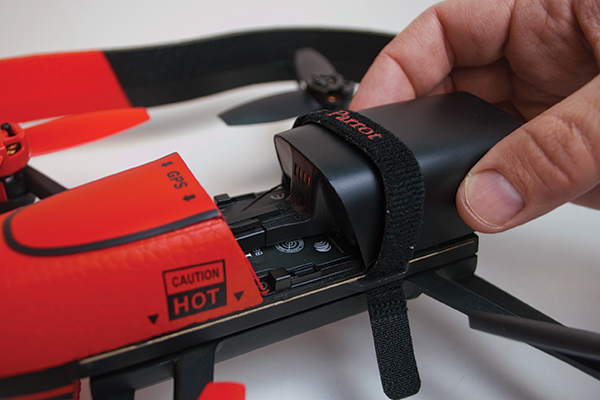
Three batteries and a one-hour AC charger are included in the Bebop with Skycontroller package.
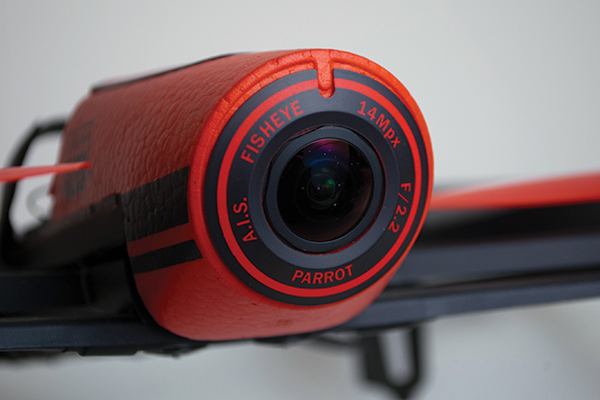
A 14 megapixel camera in the Bebop’s nose captures video at 1,080 pixels/30 frames per second.











Add new comment